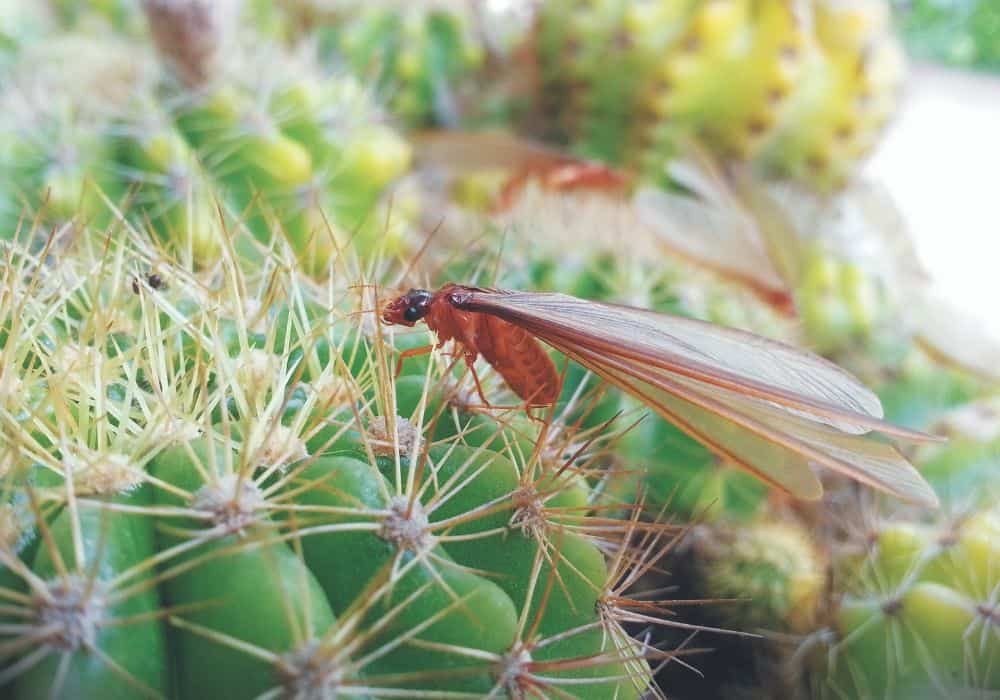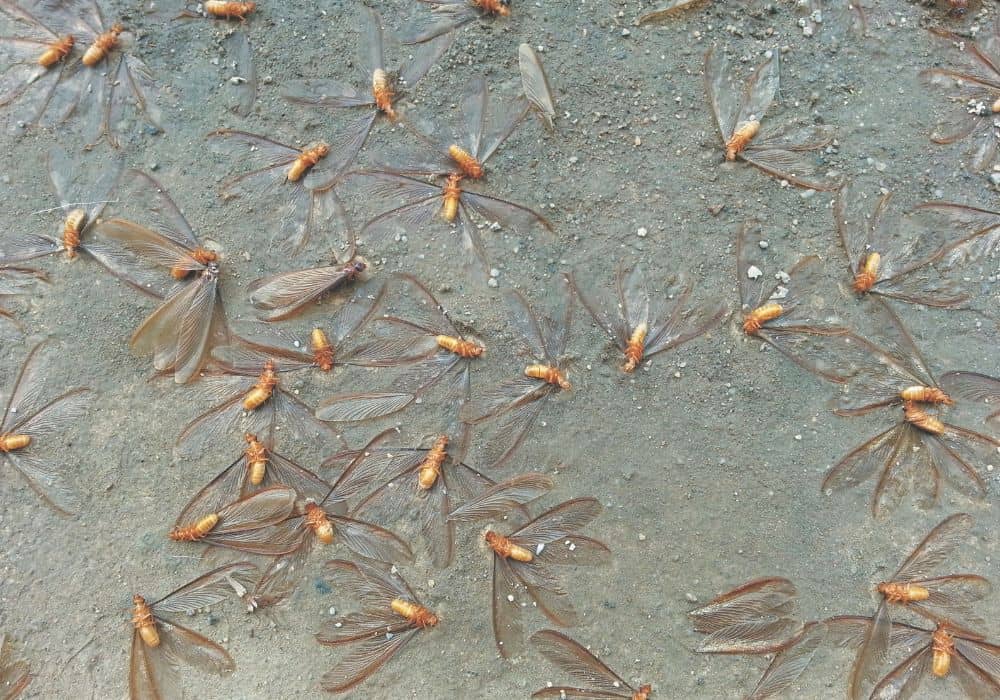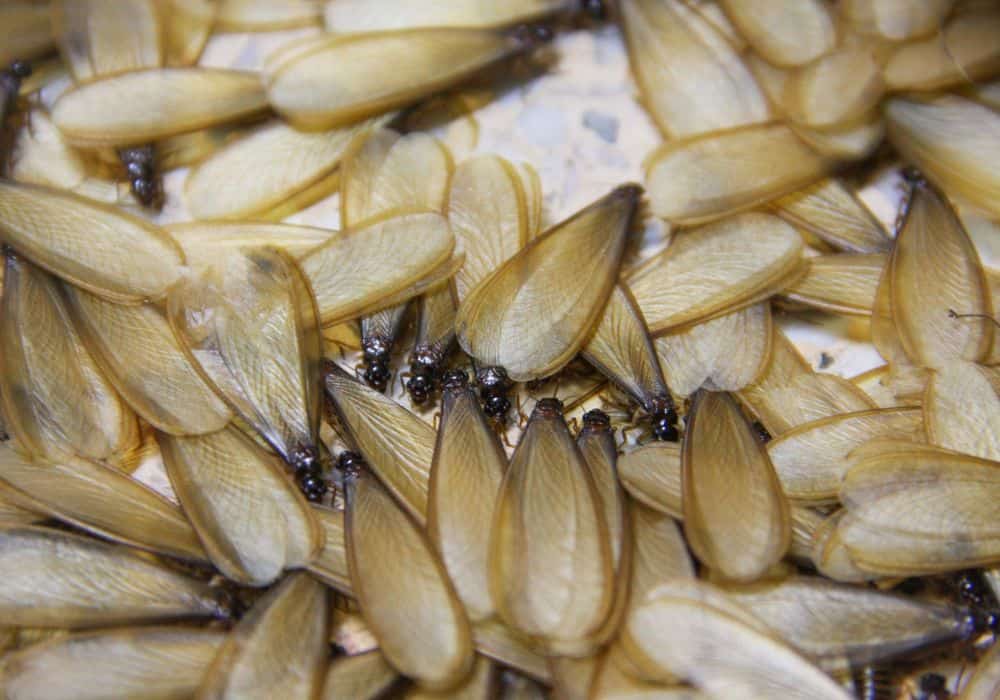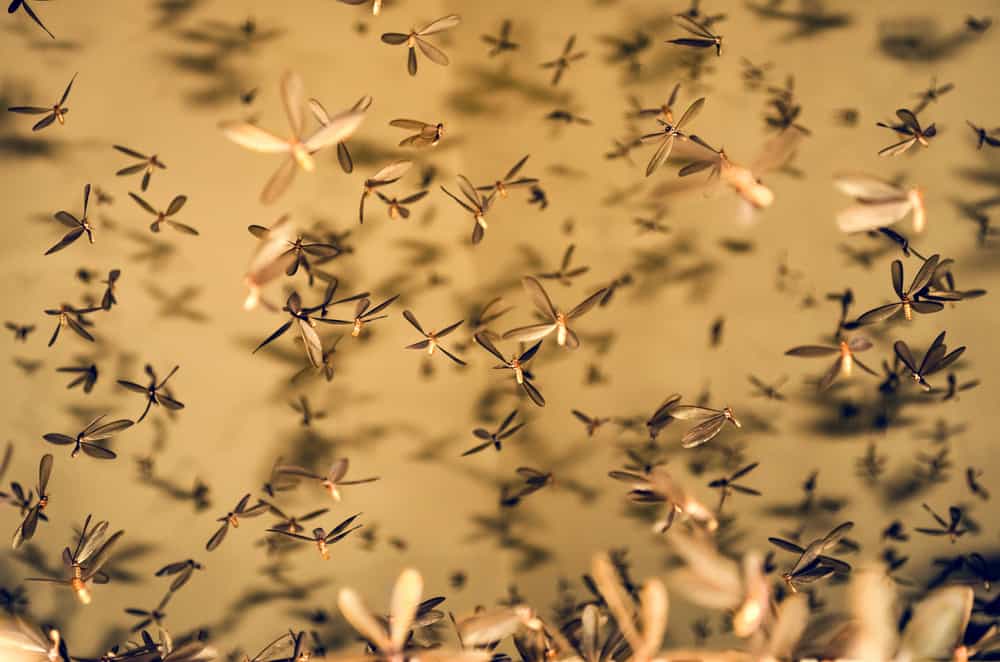Termite infestations affect more than 60,000 homes in the US annually. But what’s alarming is that these tiny wood eaters cause damages worth $5+ billion. This makes about $83,333 cost per house!
So, if you’re a homeowner with termites flying around, it’s time you look into this matter seriously and get rid of these wood-eating bugs. You don’t know how?
Well, don’t worry because today’s article will help you exactly with that. We will discuss how to get rid of flying termites in house naturally, along with prevention tips and much more. Let’s dive in!
Where Do Flying Termites Come From?

Flying termites are not a different termite specie. In fact, they are just termites who develop wings to swarm out and create a new colony.
To understand this better, let’s have a look at the development of a typical termite colony:
| Life Stage | What Happens? |
| Eggs | These are small, oval-shaped eggs laid in clusters by the Termite Queen. |
| Nymphs | After 30 days, eggs hatch into nymphs (also called larvae). They have small pale bodies with straight antennae. |
| Adult Termite Castes | It takes nymphs a year to develop into adult termites. During this time, they develop into different castes within the colony;
Each caste sets out to perform a different function to grow and expand the colony. |
| Worker Termites | The function of worker termites is to feed others and create burrows. They will also raise and protect the nymphs until they are adults.
You will only find workers in Formosan and Subterranean termites. A drywood termite colony does not have workers. Instead, the immature termites perform all the chewing and worker-class tasks. |
| Solder Termites | This type of termite is blind and has large jaws to defend the colony from predators. |
| Reproductive Individuals | Also called alates, reproductive termites have long wings that they use to fly out of the colony to mate.
The fertilized couples will shed their wings and find a new spot for the colony. They will become the King and Queen – starting the cycle all over again. |
As you can see, flying termites are just reproductive individuals of the colony. These winged termites come out in hundreds and thousands to mate in flight. This is what produces the swarm of flying termites.
In the outdoors, these swarmers come out from the holes and burrows created by the worker termites in the soil. You will find flying termites commonly in the yard or near garbage cans.
But, if the termite colony is inside the house, you should expect swarmers to come out from the cracks and crevices of the infested item (like the wall, roof, window frame, and even wooden furniture).
These swarms will move toward the light sources to get outside and create a new colony.
Are Flying Termites Dangerous?
Flying termites don’t eat wood or bite people, so they aren’t really dangerous.
Their sole purpose is to mate with another flying termite and produce a new colony. The male will fertilize a female and the pair will move outside before shedding the wings.
Unfortunately, most flying termites don’t survive this session. The swarm comes out once a year, so the flying termites aren’t great at flying. They will fall prey to predators (larger insects and birds) or get smashed into things due to high wind currents.
It is estimated that only 10% of the termite swarmers survive the mating ritual. But, if the fertilized female isn’t able to go outside within 2 weeks, she will lay the eggs somewhere in your house.
This is a huge danger!
The average Termite Queen is capable of laying 30,000 eggs in a day for up to 10 years. So, once a new colony is established, you can expect the level of worker termites (who eat the wood) to increase drastically.
And so, the rate of damage to your property will be doubled. The stability and integrity of the house structure will be greatly compromised. In severe cases, the infested structures may collapse.
It’s very important to take note of this termite problem and react quickly to control the infestation level before the fertilized female lays the eggs.
How to Get Rid of Flying Termites Naturally? 8 Proven Ways

Now that we know flying termites are signs of impending danger. Let’s have a look at ways you can stop termite damage using natural and chemical-free methods!
1. Boric Acid Spray
Boric acid is a white powder made from boron and water. It helps eliminate flying termites by blocking their digestive system and slowing down their metabolic processes. This ultimately leads to their death.
To use it, mix boric acid with water to create a solution and spray it on wooden surfaces or areas with termite activity. Termites will unknowingly ingest the acid when grooming and die. But if you can’t find boric acid, you can also use borax powder.
2. Cardboard Trap
All termites are attracted to darkness, moisture, and cellulose. So, what could be a better way to get rid of an infestation than a cardboard trap?
Just wet a cardboard piece and place it near a termite swarm or colony. Hold the cardboard steadily so that the termites settle down on it. As soon as many termites have gathered, set the cardboard ablaze with a lighter.
3. Diatomaceous Earth (DE)
Diatomaceous Earth is a naturally occurring sedimentary rock powder that is made of fossilized diatoms. When it comes in contact with termites, it penetrates their exoskeleton and causes extreme dehydration as well as death.
To use it, apply a thin layer near termite entry points or infested areas. Termites walking through the powder will get affected and will carry it back to the colony too.
4. White Vinegar Spray
If you don’t have diatomaceous earth available, you can use white vinegar. It works the same way by dehydrating the exoskeleton to death. But the main ingredient working here is the acetic acid in the vinegar.
This is what soaks into the exoskeleton and creates an imbalance in body water content. The lack of water far exceeds the termite’s ability to replace it – hence, causing death.
To use this home remedy, add 1 part of white vinegar to 3 parts of water to make a repellent solution. Transfer it into a spray bottle and use it directly on the termite swarms or colonies.
5. Orange Oil

Just like any other essential oil, orange oil is the extract from orange peels. Since it has toxic compounds, it can be used to kill flying termites by breaking down their exoskeletons and dehydrating their cell membranes.
But you don’t need to mix it with anything to use it. Just apply it directly on the infested wood and when the termite comes in contact, its exoskeleton will dissolve in seconds and the body will become dehydrated.
You can use peppermint oil or tea tree oil. However, don’t bother with a diffuser or spray. Apply the oil directly for best results.
6. Cayenne Pepper
Cayenne pepper’s strong odor and natural compounds deter flying termites. It irritates their eyes and mouth – making it impossible for them to stay.
To use, mix some cayenne pepper with water to create a DIY spray solution. Apply the mixture near termite entry points or infested areas. But make sure to wear gloves as cayenne pepper can be very spicy.
7. Beneficial Nematodes
Nematodes are microscopic, beneficial worms that parasitize insects like flying termites. They will infect and kill termites underground, which helps remove the nest altogether. So, each nematode is a natural pesticide.
You can easily purchase nematodes from gardening stores or professional pest control companies. Mix them with water as instructed and apply the solution to soil near termite colonies.
8. Sunlight Exposure
Most termites will die as soon as they are exposed to sunlight. The brightness, heat, and wind are just too much to bear for them. So, an excellent termite control method is to place the infested furniture outside in the sun.
If the flying termite swarm is inside the house, you can get rid of them by opening the curtains and windows.
Tips to Prevent Flying Termites in Your House
- Fix leaks, improve ventilation, and ensure proper drainage to reduce humidity levels (a major termite attractant).
- Clear any decaying wood, debris, or tree stumps from your property. They act as termite bait stations because of all the wood and moisture.
- Seal gaps and cracks in your home’s foundation and walls to prevent termite entry.
- Choose termite-resistant building materials for construction and renovations. Use rubber mulch wherever possible in your garden. It is made from recycled tires, so termites will be discouraged from infesting it.
- Keep shrubs and plants trimmed. They should also maintain a distance from your home’s foundation so that termites don’t have a reason to infest your property.
Summary
Flying termites are an indicator of an existing termite infestation. If not treated quickly, it can also lead to new colonies being established on your property. This can cause more damage and more loss.
So, if you see a swarm, here’s how to get rid of flying termites in house naturally:
- Boric Acid
- Cardboard
- Diamatoceous Earth (DE)
- White Vinegar
- Orange Oil
- Cayenne Pepper
- Nematodes
- Sunlight Exposure
Along with this, you should also call a professional pest control service to investigate your property. There might be more than one colony in places you couldn’t have imagined. So, contact the professional exterminator and let him handle it. Good luck!
